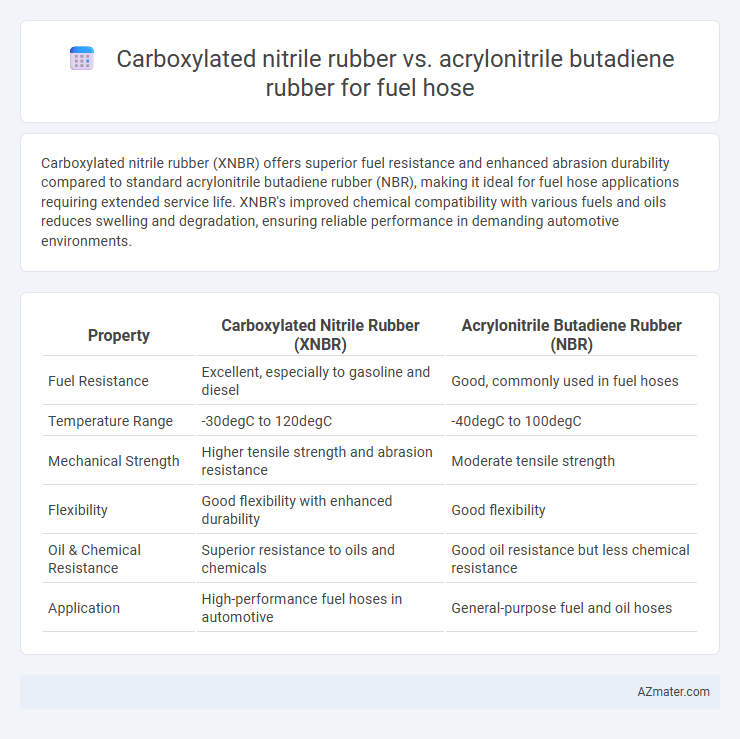Carboxylated nitrile rubber (XNBR) offers superior fuel resistance and enhanced abrasion durability compared to standard acrylonitrile butadiene rubber (NBR), making it ideal for fuel hose applications requiring extended service life. XNBR's improved chemical compatibility with various fuels and oils reduces swelling and degradation, ensuring reliable performance in demanding automotive environments.
Table of Comparison
| Property | Carboxylated Nitrile Rubber (XNBR) | Acrylonitrile Butadiene Rubber (NBR) |
|---|---|---|
| Fuel Resistance | Excellent, especially to gasoline and diesel | Good, commonly used in fuel hoses |
| Temperature Range | -30degC to 120degC | -40degC to 100degC |
| Mechanical Strength | Higher tensile strength and abrasion resistance | Moderate tensile strength |
| Flexibility | Good flexibility with enhanced durability | Good flexibility |
| Oil & Chemical Resistance | Superior resistance to oils and chemicals | Good oil resistance but less chemical resistance |
| Application | High-performance fuel hoses in automotive | General-purpose fuel and oil hoses |
Introduction to Fuel Hose Material Selection
Carboxylated nitrile rubber (XNBR) offers enhanced chemical resistance and tensile strength compared to standard acrylonitrile butadiene rubber (NBR), making it more suitable for fuel hose applications exposed to aggressive fuels and additives. The higher carboxyl content in XNBR improves fuel permeation resistance and durability under thermal stress, extending service life in modern fuel systems. Selecting fuel hose materials involves balancing resistance to fuel swelling, ozone, and mechanical wear, where XNBR presents a preferred option for demanding operating conditions.
Overview of Carboxylated Nitrile Rubber (XNBR)
Carboxylated nitrile rubber (XNBR) offers superior oil and fuel resistance compared to standard acrylonitrile butadiene rubber (NBR) due to the incorporation of carboxylic acid groups, which enhance its chemical and mechanical properties. XNBR exhibits improved tensile strength, abrasion resistance, and temperature stability, making it highly suitable for fuel hoses subject to harsh operating conditions. Its enhanced polar interactions contribute to better adhesion with metal and fabric reinforcements, ensuring durability and long service life in automotive and industrial fuel line applications.
Overview of Acrylonitrile Butadiene Rubber (NBR)
Acrylonitrile Butadiene Rubber (NBR) is a synthetic rubber widely used in fuel hose applications due to its excellent resistance to oils, fuels, and other hydrocarbons. Its molecular structure provides superior impermeability and durability under varying temperature conditions, making it ideal for automotive fuel systems. Compared to Carboxylated nitrile rubber, NBR offers enhanced compatibility with petroleum-based fluids and improved tensile strength, ensuring long-lasting performance in demanding environments.
Chemical Resistance: XNBR vs NBR
Carboxylated nitrile rubber (XNBR) exhibits superior chemical resistance compared to acrylonitrile butadiene rubber (NBR), particularly against fuels and oils, making it more durable for fuel hose applications. XNBR's enhanced cross-linking due to carboxyl groups provides improved swelling resistance and hardness retention in aggressive fuel environments. NBR, while effective with moderate resistance to hydrocarbons, typically shows greater degradation and swelling when exposed to harsh chemicals over extended periods.
Mechanical Properties Comparison
Carboxylated nitrile rubber (XNBR) exhibits superior tensile strength and abrasion resistance compared to standard acrylonitrile butadiene rubber (NBR), making it more suitable for high-pressure fuel hose applications. XNBR's enhanced cross-linking density provides better tear resistance and elasticity, critical for maintaining hose integrity under dynamic fuel flow conditions. NBR, while offering good oil and fuel resistance, generally has lower mechanical durability, limiting its use in environments requiring prolonged mechanical stress endurance.
Temperature Tolerance and Performance
Carboxylated nitrile rubber (XNBR) offers superior temperature tolerance, typically functioning effectively between -40degC to 120degC, compared to acrylonitrile butadiene rubber (NBR), which operates optimally from -30degC to 100degC in fuel hose applications. The enhanced cross-linking in XNBR improves fuel resistance and mechanical performance, making it more durable under high-temperature and pressure conditions. NBR remains cost-effective with good fuel resistance but underperforms XNBR in thermal stability and long-term durability for demanding fuel hose environments.
Abrasion and Wear Resistance
Carboxylated nitrile rubber (XNBR) offers superior abrasion and wear resistance compared to standard acrylonitrile butadiene rubber (NBR), making it ideal for fuel hoses exposed to mechanical stress and friction. The presence of carboxyl groups in XNBR enhances cross-linking density, resulting in improved durability and longer service life under harsh operating conditions. In contrast, NBR provides good fuel resistance but generally exhibits lower abrasion resistance, leading to faster wear in applications requiring high mechanical endurance.
Cost Considerations and Availability
Carboxylated nitrile rubber (XNBR) typically has higher raw material costs compared to standard acrylonitrile butadiene rubber (NBR) due to its enhanced chemical resistance and durability, which can increase the overall fuel hose price. NBR is widely available and cost-effective, making it a popular choice for fuel hoses in large-scale manufacturing where budget constraints are critical. However, XNBR's specialized properties justify its premium cost in applications requiring superior fuel and oil resistance, despite more limited supply and higher procurement expenses.
Applications in Fuel Hose Industry
Carboxylated nitrile rubber (XNBR) exhibits superior fuel resistance, ozone resistance, and mechanical strength, making it ideal for high-performance fuel hose applications requiring durability under harsh chemical exposure. Acrylonitrile butadiene rubber (NBR), valued for its excellent oil and fuel resistance combined with cost-effectiveness, is widely used in standard fuel hose manufacturing where moderate temperature and abrasion resistance suffice. The fuel hose industry leverages XNBR for advanced automotive and aerospace fuel delivery systems demanding extended lifespan and reliability, while NBR is preferred for conventional fuel hoses in automotive and industrial sectors due to its balance of performance and affordability.
Summary: Choosing Between XNBR and NBR for Fuel Hoses
Carboxylated nitrile rubber (XNBR) offers enhanced oil resistance, improved tensile strength, and better abrasion resistance compared to standard acrylonitrile butadiene rubber (NBR), making it suitable for high-performance fuel hoses exposed to harsh chemicals and extreme conditions. While NBR provides good fuel and oil resistance at a lower cost, its mechanical properties may degrade faster in demanding environments. Selecting between XNBR and NBR depends on balancing budget constraints with the required durability, chemical resistance, and operational longevity of the fuel hose application.

Infographic: Carboxylated nitrile rubber vs Acrylonitrile butadiene rubber for Fuel hose
 azmater.com
azmater.com